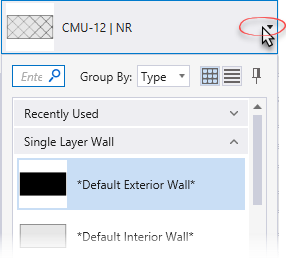Edit Space
The
Edit Space dialog also opens when; double
clicked OR
on a selected single space.
Note: All property values can be edited except Actual Area. The Edit Space cannot change the physical size of a space boundary and therefore cannot edit the actual area value of a space.
Actual Area and Perimeter property values can be edited only for spaces that are created with no shape boundary. In that case, simply select the space label to edit the properties in the Edit Space dialog.
| Setting | Description |
|---|---|
| Catalog Item Selector |
Used to select from available
Catalog Items. The
Catalog Item Selector combo box contains
several options and settings designed to make it easier to find the exact
catalog item you need to place/change.
The
Catalog Item list also includes user
defined assemblies, and RFA catalog items, if any.
|
| Catalog Tools |
A split button located to the right of the
Catalog Item Selector contains tools to
assist with managing catalog data prior to placement of selected catalog items.
|
| Properties list - toolbar |
Used to manage catalog item properties during
placement or modification. Catalog item properties define the catalog item
instance in the model, and are accountable in the DataGroup System data
management tools. You can place a catalog item with its default property values
or you can change property values as needed, place an instance in the model,
and optionally save the changes to the catalog.
The Properties combo box contains tools for sorting and searching the properties list:
|
| Space Parameters |
|
| Materials | Lists Part and Family definition assignments. Clicking in the Value column cell opens a Family and Part selection box. Here parts and families are available from the option menus. |
| Energy Analysis |
|
| IFC Override | Lists IFC properties not automatically mapped to DataGroup System properties that can be manipulated for export. |
| Space | Contains space data properties for notes, location, occupancy, finishes, and mechanical and electrical requirements. Data properties can be entered directly in the provided text entry fields or be selected (where available) from predefined drop down menus. Properties are stored on the space component and can be edited with the Modify properties tool and be reported on with the Schedules tool. |
| Discipline | Sets one of the disciplines from pull-down options: Architectural, Structural, Mechanical, and Electrical. |
| Classification | Building Classification Systems are supported by the DataGroup System. MasterFormat, OmniClass, and UniFormat property values can be associated with any Building element. Click the Value cell to open the Classification System selection combo box. The combo box is populated with selected classification system property values. It can be resized by clicking on the combo box's bottom right corner. Search for properties by name. Search results are displayed in the classifications hierarchy. Double click a property to select it. This action also closes the selection menu. The selected property displays in the selected classification system property value (on the Properties list). |
Note:
Information in the
Value column rows can be completed by selecting
the applicable cell to activate an editor field, an option menu, or a pop up
dialog. This data is written to the element properties. Properties displayed
with grey text are read only. Some of these are set in the placement tool's
Placement tab, and can be modified there. The
dividing bar between the
Property, and
Value columns can be moved to change the width
of either area, or resize the dialog. A vertical and horizontal scroll bars are
available to scroll and adjust
Properties panel viewing and the display of
data.



 (
( (
( (
( (
( (
( (
( (
( (
( (
(
